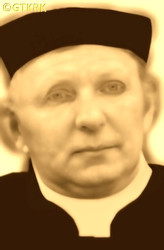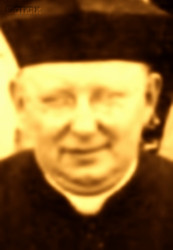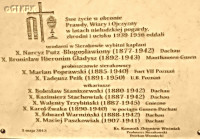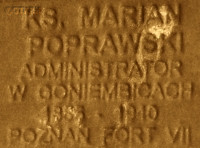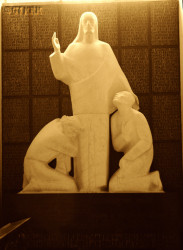Roman Catholic
St Sigismund parish
05-507 Słomczyn
85 Wiślana Str.
Konstancin deanery
Warsaw archdiocese, Poland
full list:
displayClick to display full list

searchClick to search full list by categories
wyświetlKliknij by wyświetlić pełną listę po polsku

szukajKliknij by przeszukać listę wg kategorii po polsku

Martyrology of the clergy — Poland
XX century (1914 – 1989)
personal data
surname
POPRAWSKI
forename(s)
Marian
function
diocesan priest
creed
Latin (Roman Catholic) Church RCmore on
en.wikipedia.org
[access: 2014.09.21]
diocese / province
Gniezno and Poznań archdiocese (aeque principaliter)more on
www.archpoznan.pl
[access: 2012.11.23]
RC Military Ordinariate of Polandmore on
en.wikipedia.org
[access: 2014.12.20]
honorary titles
„Medal of Independence”more on
en.wikipedia.org
[access: 2019.02.02]
(27.06.1938)
Silver „Cross of Merit”more on
en.wikipedia.org
[access: 2019.04.16]
(21.12.1927)
„Iron Cross” i.e. Germ. „Eisernes Kreuz” (German Empire) — 2nd classmore on
en.wikipedia.org
[access: 2020.04.25]
date and place
of death
30.01.1940

KL Posenconcentration camp
today: Poznań, Poznań city pov., Greater Poland voiv., Poland
more on
en.wikipedia.org
[access: 2022.01.09]
alt. dates and places
of death
28‑29.01.1940
details of death
During the Prussian rule in partitioned Poland, while studying at the Germ. Königliches Gymnasium (Eng. Royal Gymnasium) in Gniezno, a member of the clandestine Polish self‐educational student organization Thomas Zan Society. In 1902 expelled from school by the German authorities. A year later, on 08‐09.06.1903, the Germans brought a trial against 24 students and graduates of the gymnasium, which took place before the Criminal Chamber of the Land Court in Gniezno. Refused to testify and was sentenced to a reprimand (16 boys were sentenced to prison, 3 received reprimands).
During World War I, 1914‐1918, a chaplain of the German Imperial Army — prob. served in the Poznań garrison and in one of the German army divisions.
After the abdication on 09.11.1918 of the German Emperor William II Hohenzollern; after the signing on 11.11.1918 by the Allies and the Germans, in the staff carriage in Compiègne, at the headquarters of French Marshal Ferdinand Foch, of the armistice and ceasefire — which de facto meant the end of World War I; and also after the handover on 11.11.1918 by the Regency Council — operating in the so‐called Germ. Königreich Polen (Eng. Polish Kingdom), i.e. the territory occupied by the Central Powers (Germany and Austria–Hungary) — supreme authority over the army to Brigadier Joseph Piłsudski and his appointment as Commander‐in‐Chief of the Polish Army, which de facto meant the rebirth of the Polish state, encompassing however only the Germ. Königreich Polen, i.e. the Polish territory under Russian rule until 1915, but excluding the lands of the Prussian partition, which were still formally part of the German state; became a member of the People's Council established in Sieraków — at the appeal of the People's Council in Poznań, supporting the peaceful takeover of the lands of the Prussian partition by the reborn Polish state. Greater Poland, however, was still formally part of the German state, so the German paramilitary organization Germ. Grenzschutz Ost (Eng. Eastern Border Guard) became active. It was established after the German defeat in the war and opposed the separation of the eastern territories to Poland. Suggested then the initiative to send a special delegation to Paris, where peace negotiations were taking place, which resulted in the Treaty of Versailles signed on 28.06.1919, regarding the terror used against the Polish population by the Germ. Grenzschutz Ost. In 12, 1918, also organized Polish rallies in the neighboring Germ. Kreis Filehne (Eng. Wieluń County) — his parish Sieraków was located in Germ. Kreis Birnbaum (Eng. Międzychód County); both counties in the Prussian part of portioned Poland, i.e. in Germ. Provinz Posen (Eng. Poznań province) — where German influence was very strong.
On 27.12.1918, the Greater Poland Uprising broke out. In Sieraków the direct spark that caused the uprising was the arrival on 06.01.1919, of a 40‐strong armed group of Germans, who stole several Arabian stallions from a famous local stud farm. The next day, an insurgent unit from Pniewy and Szamotuły appeared in Sieraków. The town offices were taken over. Polish flags were hung over Sieraków.
On 19.01.1919, after a solemn Mass, which celebrated, the insurgent company formed in Sieraków marched, while singing „God who surrounded Poland”, from the parish church to the market square decorated with national flags and was sworn in there.
For the mayor of Międzychód, in a letter dated 21.07.1927, prepared a list of participants in the Greater Poland Uprising and distinguished servicemen from the pre‐uprising period from Sieraków and the surrounding area.
After German and Russian invasion of Poland in 09.1939 and start of the World War II, after start of German occupation, arrested by the Germans on 27.10.1939.
Jailed in Leszno prison.
From there moved to KL Posen (Fort VII) concentration camp.
There tortured and finally murdered — Germans ordered him and few other Polish prisoners (including pastor Gustav Manitius) to run along a narrow side corridor and started to shoot at them.
According to the death certificate in the registers of the civil registry office in Poznań, No. 31/1295/1940, the „honest” otherwise German „medical doctors” and formalists — and at the same time, unrivaled fairy tale spinners — noted the cause of death was „heart stroke” (according to some sources „apoplexy”).
cause of death
mass murder
perpetrators
Germans
sites and events
KL PosenClick to display the description, LesznoClick to display the description, «Intelligenzaktion»Click to display the description, Ribbentrop‐MolotovClick to display the description, Pius XI's encyclicalsClick to display the description, Greater Poland UprisingClick to display the description, Thomas Zan SocietiesClick to display the description
date and place
of birth
08.09.1885Birth certification on:
photos.szukajwarchiwach.gov.pl
[access: 2025.08.19]

Żerkówtoday: Żerków gm., Jarocin pov., Greater Poland voiv., Poland
more on
en.wikipedia.org
[access: 2021.12.18]
parents
POPRAWSKI Martin
🞲 ?, ? — 🕆 ?, ?

KRUKOWSKA Pelagia
🞲 ?, ? — 🕆 ?, ?
presbyter (holy orders)
ordination
30.01.1910

Poznańtoday: Poznań city pov., Greater Poland voiv., Poland
more on
en.wikipedia.org
[access: 2021.07.18]
St Peter and St Paul the Apostles RC archcathedral churchmore on
en.wikipedia.org
[access: 2025.03.14]
positions held
1933 – 1939
administrator — Goniembicetoday: Lipno gm., Leszno pov., Greater Poland voiv., Poland
more on
en.wikipedia.org
[access: 2022.02.03] ⋄ St Nicholas the Bishop and Confessor RC parish ⋄ Lesznotoday: Leszno city pov., Greater Poland voiv., Poland
more on
en.wikipedia.org
[access: 2021.07.18] RC deanery
1931 – 1933
parish priest — Janków Zaleśnytoday: Raszków gm., Ostrów Wielkopolski pov., Greater Poland voiv., Poland
more on
en.wikipedia.org
[access: 2021.07.18] ⋄ St Adalbert the Bishop and Martyr and Nativity of the Blessed Virgin Mary RC parish ⋄ Ostrów Wielkopolskitoday: Ostrów Wielkopolski urban gm., Ostrów Wielkopolski pov., Greater Poland voiv., Poland
more on
en.wikipedia.org
[access: 2021.06.07] RC deanery
1918 – 1931
parish priest — Sierakówtoday: Sieraków gm., Międzychód pov., Greater Poland voiv., Poland
more on
en.wikipedia.org
[access: 2021.12.18] ⋄ Blessed Virgin Mary Immaculate Conception RC parish ⋄ Wronkitoday: Wronki gm., Szamotuły pov., Greater Poland voiv., Poland
more on
en.wikipedia.org
[access: 2021.06.20] RC deanery — also: secretary of the Supervisory Board of the People's Bank; 1926 member of the Committee of the People's Reading Rooms Society TCL for the Międzychód county
1914 – 1918
RC military chaplain — German Imperial Army
1910 – c. 1915
vicar — PoznańOstrów Tumski
today: Poznań city pov., Greater Poland voiv., Poland
more on
en.wikipedia.org
[access: 2022.02.03] ⋄ St Peter and St Paul the Apostles RC archcathedral church
1913
priest — Braunschweigtoday: Braunschweig urban dist., Lower Saxony state, Germany
more on
en.wikipedia.org
[access: 2021.12.18] ⋄ Polish Catholic Mission — acting („ad interim”), among Polish emigrants and migrants
1911
vicar — Nowe Miasto nad Wartątoday: Nowe Miasto nad Wartą gm., Środa Wielkopolska pov., Greater Poland voiv., Poland
more on
en.wikipedia.org
[access: 2020.11.27] ⋄ Holy Trinity RC parish ⋄ Nowe Miasto nad Wartątoday: Nowe Miasto nad Wartą gm., Środa Wielkopolska pov., Greater Poland voiv., Poland
more on
en.wikipedia.org
[access: 2020.11.27] RC deanery — acting („ad interim”)
1910 – 1911
administrator — Rawicztoday: Rawicz gm., Rawicz pov., Greater Poland voiv., Poland
more on
en.wikipedia.org
[access: 2021.07.15] ⋄ Annunciation to the Blessed Virgin Mary RC parish ⋄ Krobiatoday: Krobia gm., Gostyń pov., Greater Poland voiv., Poland
more on
en.wikipedia.org
[access: 2021.07.18] RC deanery — acting („ad interim”)
till 1910
student — Gnieznotoday: Gniezno urban gm., Gniezno pov., Greater Poland voiv., Poland
more on
en.wikipedia.org
[access: 2021.12.18] ⋄ philosophy and theology, Archbishop's Practical Theological Seminary (Lat. Seminarium Clericorum Practicum)
from 1906
student — Poznańtoday: Poznań city pov., Greater Poland voiv., Poland
more on
en.wikipedia.org
[access: 2021.07.18] ⋄ philosophy and theology, Archbishop's Theological Seminary (Collegium Leoninum)
others related
in death
CEGIEŁClick to display biography Thaddeus Vladimir Cornelius, FLACHClick to display biography Julian, GRAMLEWICZClick to display biography Edward, HARASYMOWICZClick to display biography Vincent, JANICKIClick to display biography Stanislav, JANKOWSKIClick to display biography Alphonse, KUBIKClick to display biography Alexander, ŁUKOWSKIClick to display biography Steven, MAŁECKIClick to display biography Stanislav, MANITIUSClick to display biography Gustav, MIROCHNAClick to display biography Steven Marian (Fr Julian), MZYKClick to display biography Louis, NIEDBAŁClick to display biography Anthony Marian, NOWAKClick to display biography Francis Joseph, PIOTROWSKIClick to display biography Ignatius, SĘKIEWICZClick to display biography Mauritius Vaclav, STEINMETZClick to display biography Paul, SZREYBROWSKIClick to display biography Casimir, TYMAClick to display biography Joseph, WIŚNIEWSKAClick to display biography Mary, WOŹNIAKClick to display biography Albin, GRAETZClick to display biography Ceslav John Michael, KAŹMIERSKIClick to display biography Boleslav, WINGERClick to display biography Leo
sites and events
descriptions
KL Posen: German Posen — Fort VII — camp founded in c. 10.10.1939 in Poznań till mid of 11.1939 operated formally as Germ. Konzentrationslager (Eng. concentration camp) KL Posen, and this term is used throughout the White Book, also later periods. It was first such a concentration camp set up by the Germans on Polish territory — in case of Greater Poland (Wielkopolska) directly incorporated into German Reich. In 10.1939 in KL Posen for the first time Germans used gas to murder civilian population, in particular patients of local psychiatric hospitals. From 11.1939 the camp operated as German political police Gestapo prison and transit camp (Germ. Übergangslager), prior to sending off to concentration camps, such as KL Dachau or KL Auschwitz. In 28.05.1941 the camp was rebranded as police jail and slave labour corrective camp (Germ. Arbeitserziehungslager). At its peak up to 7‐9 executions were carried in the camp per day, there were mass hangings of the prisoners and some of them were led out to be murdered elsewhere, outside of the camp. Altogether in KL Posen Germans exterminated approx. 20,000 inhabitants of Greater Poland (Wielkopolska) region, including many representatives of Polish intelligentsia, patients and staff of psychiatric hospitals and dozen or so Polish priests. Hundreds of priests were held there temporarily prior to transport to other concentration camps, mainly KL Dachau. From 03.1943 the camp had been transformed into an industrial complex (from 25.04.1944 — Telefunken factory manufacturing radios for submarines and aircrafts). (more on: www.wmn.poznan.plClick to attempt to display webpage
[access: 2019.02.02], en.wikipedia.orgClick to attempt to display webpage
[access: 2013.12.27])
Leszno: Detention centre and prison during World War II run by Germans. After cessation of hostilities in 1945 prison run by Polish Commie‐Nazi authorities, controlled by Russians. (more on: www.sw.gov.plClick to attempt to display webpage
[access: 2013.08.17])
«Intelligenzaktion»: German: «Intelligenzaktion» (English: „Intelligence Action”) — a German program of extermination of the Polish elite, mainly the intelligentsia and leadership layers, carried out from the beginning of the occupation in w 09.1939 to 04.1940, mainly in territories directly annexed to Germany, but also in the so‐called Germ. Generalgouvernement (Eng. General Governorate), where it was called «AB‐aktion». In the first phase, immediately after the beginning of the German occupation, during military operations carried out by the Germ. Wehrmacht (Eng. Armed Forces) and the genocidal units of the Germ. Einsatzgruppen (Eng. Operational Groups) of the Germ. Sicherheitspolizei (Eng. Security Police), i.e. SiPo, and Germ. Sicherheitsdienst des Reichsführers SS (Eng. Security Service of the Reichsführer SS), i.e. SD, organized by the Germ. Reichssicherheitshauptamt (Eng. Reich Main Security Office), i.e. RSHA, which followed the troops, carried out under the Germ. Unternehmen „Tannenberg” (Eng. Operation „Tannenberg”) — based on the so‐called Germ. Sonderfahndungsliste (Eng. Special Wanted Lists), i.e. proscription lists of Poles considered particularly dangerous to the Third Reich, prepared by the Zentralstelle II/P (Polen) unit of the German RSHA. Later, implemented by the German civilian occupation authorities and the genocidal unit of the Germ. Volksdeutscher Selbstschutz (Eng. Ethnic Germans Self‐Defense), whose members were Germ. Volksdeutsche (Eng. Ethnic Germans), i.e. representatives of the German minority in Poland. According to various sources, these lists, at the beginning of 09.1939, could have contained the details of 61,000—88,000 „dangerous” Poles — although these figures cannot be confirmed. In total, during this genocide, c. 50,000 teachers, Catholic priests, representatives of the landed gentry, freelancers, social and political activists, and retired military personnel were systematically and methodically murdered. Another 50,000 were sent to concentration camps, where only a negligible percentage survived. (more on: en.wikipedia.orgClick to attempt to display webpage
[access: 2014.10.04])
Ribbentrop‐Molotov: Genocidal Russian‐German alliance pact between Russian leader Joseph Stalin and German leader Adolf Hitler signed on 23.08.1939 in Moscow by respective foreign ministers, Mr. Vyacheslav Molotov for Russia and Joachim von Ribbentrop for Germany. The pact sanctioned and was the direct cause of joint Russian and German invasion of Poland and the outbreak of the World War II in 09.1939. In a political sense, the pact was an attempt to restore the status quo ante before 1914, with one exception, namely the „commercial” exchange of the so‐called „Kingdom of Poland”, which in 1914 was part of the Russian Empire, fore Eastern Galicia (today's western Ukraine), in 1914 belonging to the Austro‐Hungarian Empire. Galicia, including Lviv, was to be taken over by the Russians, the „Kingdom of Poland” — under the name of the General Governorate — Germany. The resultant „war was one of the greatest calamities and dramas of humanity in history, for two atheistic and anti‐Christian ideologies — national and international socialism — rejected God and His fifth Decalogue commandment: Thou shall not kill!” (Abp Stanislav Gądecki, 01.09.2019). The decisions taken — backed up by the betrayal of the formal allies of Poland, France and Germany, which on 12.09.1939, at a joint conference in Abbeville, decided not to provide aid to attacked Poland and not to take military action against Germany (a clear breach of treaty obligations with Poland) — were on 28.09.1939 slightly altered and made more precise when a treaty on „German‐Russian boundaries and friendship” was agreed by the same murderous signatories. One of its findings was establishment of spheres of influence in Central and Eastern Europe and in consequence IV partition of Poland. In one of its secret annexes agreed, that: „the Signatories will not tolerate on its respective territories any Polish propaganda that affects the territory of the other Side. On their respective territories they will suppress all such propaganda and inform each other of the measures taken to accomplish it”. The agreements resulted in a series of meeting between two genocidal organization representing both sides — German Gestapo and Russian NKVD when coordination of efforts to exterminate Polish intelligentsia and Polish leading classes (in Germany called «Intelligenzaktion», in Russia took the form of Katyń massacres) where discussed. Resulted in deaths of hundreds of thousands of Polish intelligentsia, including thousands of priests presented here, and tens of millions of ordinary people,. The results of this Russian‐German pact lasted till 1989 and are still in evidence even today. (more on: en.wikipedia.orgClick to attempt to display webpage
[access: 2015.09.30])
Pius XI's encyclicals: Facing the creation of two totalitarian systems in Europe, which seemed to compete with each other, though there were more similarities than contradictions between them, Pope Pius XI issued in 03.1937 (within 5 days) two encyclicals. In the „Mit brennender Sorge” (Eng. „With Burning Concern”) published on 14.03.1938, condemned the national socialism prevailing in Germany. The Pope wrote: „Whoever, following the old Germanic‐pre‐Christian beliefs, puts various impersonal fate in the place of a personal God, denies the wisdom of God and Providence […], whoever exalts earthly values: race or nation, or state, or state system, representatives of state power or other fundamental values of human society, […] and makes them the highest standard of all values, including religious ones, and idolizes them, this one […] is far from true faith in God and from a worldview corresponding to such faith”. On 19.03.1937, published „Divini Redemptoris” (Eng. „Divine Redeemer”), in which criticized Russian communism, dialectical materialism and the class struggle theory. The Pope wrote: „Communism deprives man of freedom, and therefore the spiritual basis of all life norms. It deprives the human person of all his dignity and any moral support with which he could resist the onslaught of blind passions […] This is the new gospel that Bolshevik and godless communism preaches as a message of salvation and redemption of humanity”… Pius XI demanded that the established human law be subjected to the natural law of God , recommended the implementation of the ideal of a Christian state and society, and called on Catholics to resist. Two years later, National Socialist Germany and Communist Russia came together and started World War II. (more on: www.vatican.vaClick to attempt to display webpage
[access: 2023.05.28], www.vatican.vaClick to attempt to display webpage
[access: 2023.05.28])
Greater Poland Uprising: Military insurrection of Poles of former German Germ. Posen Provinz (Eng. Poznań province) launched against German Reich in 1918‐1919 — after the abdication on 09.11.1918 of the German Emperor William II Hohenzollern; after the armistice between the Allies and Germany signed on 11.1.1918 in the HQ wagon in Compiègne, the headquarters of Marshal of France Ferdinand Foch — which de facto meant the end of World War I — against the German Weimar Republic, established on the ruins of the German Empire, aiming to incorporate lands captured by Prussia during partitions of Poland in XVIII century into Poland. The Republic of Poland, reborn on 11.11.1918, initially formally included only the so‐called Germ. Königreich Polen (Eng. Kingdom of Poland), i.e. the territory that had been under Russian rule until 1915 and then under the control of Central States (Germany and Austria–Hungary), but did not include the Prussian partition. Started on 27.12.1918 in Poznań and ended on 16.02.1919 with the armistice pact in Trier, forced by the victorious Entente states, which included provisions ordering Germany to cease operations against Poland and, importantly, recognizing the Polish insurgent Greater Poland Army as an allied armed force of the Entente. De facto it turned out to be a Polish victory, confirmed in the main peace treaty after World War I, the Treaty of Versailles of 28.06.1919, which came into force on 10.01.1920 and in which most of the lands of the Prussian partition were recognized as Polish. Many Polish priests took part in the Uprising, both as chaplains of the insurgents units and members and leaders of the Polish agencies and councils set up in the areas covered by the Uprising. In 1939 after German invasion of Poland and start of the World War II those priests were particularly persecuted by the Germans and majority of them were murdered. (more on: en.wikipedia.orgClick to attempt to display webpage
[access: 2016.08.14])
Thomas Zan Societies: Secret societies of Polish youth, aiming at self‐education, patriotic in form and content, functioning 1830‐1920, in mutiny against enforced Germanisation and censure of Polish culture, mainly in secondary schools — gymnasia — mainly in Greater Poland (Wielkopolska) and later in Silesia. The first groups were formed in 1817. In 1897 a congress in Bydgoszcz was held when rules of clandestine activities were formulated. At other congress in Bydgoszcz in Poznań a „Red Rose” society was formed, heading all others groups in various gymnasiums and coordinating their activities. In 1900 „Red Rose” consolidated Philomaths organizations from Pomerania as well. After Toruń trial of Pomeranian Philomaths in Toruń Germans arrested 24 members of Thomas Zan Society from Gniezno. 21 of them were sentenced up to 6 weeks in prison and reprimands. All were relegated from schools without the right to continue education in secondary and higher schools in Prussia. Despite repression the Societies existed till 1918 and rebirth of Poland. (more on: pl.wikipedia.orgClick to attempt to display webpage
[access: 2021.12.19])
sources
personal:
www.wtg-gniazdo.orgClick to attempt to display webpage
[access: 2012.11.23], www.informator-miedzychodzki.plClick to attempt to display webpage
[access: 2013.12.27], www.wbc.poznan.plClick to attempt to display webpage
[access: 2015.09.30], photos.szukajwarchiwach.gov.plClick to attempt to display webpage
[access: 2025.08.19], www.straty.plClick to attempt to display webpage
[access: 2015.04.18], www.przybylscy.plClick to attempt to display webpage
[access: 2013.08.10], kpbc.umk.plClick to attempt to display webpage
[access: 2020.04.25]
bibliographical:
„Social Activist Priests in Greater Poland”, collective work, Biographical Dictionary, vol. 3 P‐S, Gniezno 2008
original images:
www.wbc.poznan.plClick to attempt to display webpage
[access: 2015.09.30], www.parafia.sierakow.plClick to attempt to display webpage
[access: 2014.01.06]
LETTER to CUSTODIAN/ADMINISTRATOR
If you have an Email client on your communicator/computer — such as Mozilla Thunderbird, Windows Mail or Microsoft Outlook, described at WikipediaPatrz:
en.wikipedia.org, among others — try the link below, please:
LETTER to CUSTODIAN/ADMINISTRATORClick and try to call your own Email client
If however you do not run such a client or the above link is not active please send an email to the Custodian/Administrator using your account — in your customary email/correspondence engine — at the following address:

giving the following as the subject:
MARTYROLOGY: POPRAWSKI Marian
To return to the biography press below:
 Click to return to biography
Click to return to biography








